Package Passion: The modern consumer's desire to track every parcel stems from a mix of anticipation and control, making package tracking an essential and oddly satisfying part of the shopping experience.
Waiting's New Hobby: Tracking parcels has transformed waiting into a delightful hobby, offering a sense of involvement in the delivery journey, ensuring consumers are always in the know.
Doorstep Drama: Every update sprinkles a bit of excitement on an otherwise ordinary day, as parcel tracking transforms deliveries into events worth eagerly anticipating.
Control Freaks Unite: Real-time tracking provides consumers with a reassuring sense of control over their purchases, allaying anxieties and ensuring expectations are met regarding delivery times and locations.
The App Addiction: Dedicated apps fuel the obsession, providing constant updates that keep users engaged in their package's journey, making sure they're never left in the dark about delays or estimated arrivals.
We’re OBSESSED with tracking our parcels.
I don’t mean that lightly. I mean, psychologists have weighed in and tried to study what happens to our brains when we’re waiting for our orders to arrive.
In fact, the Urban Dictionary calls it “pre-parcel anxiety.”

A new Verte study shows that consumers value package tracking from shipment to delivery the most when ordering online.
And if the package is running late?
One in five (21%) surveyed say that waiting a day past the expected delivery is too much of a delay.
For your ecommerce business, this means one thing: your delivery communication is less about logistics and more about emotional support.
Get it right, and you transform anxiety into excitement, directly boosting customer satisfaction. Get it wrong, and you risk losing customer trust.
This is your clear guide on how to inform customers about delivery status—tools and templates at the ready.
Why Transparent Delivery Communications Matter (Like A Lot)
I asked my editor—Sean—to let me write on this topic, not just because I've got some hot insights as a former online store owner, but more so because I shop like it's an Olympic sport.
Yes, I can tell you everything I did to keep my customers happy, but I'm going to take a different approach—and tell you what makes me a happy customer.
The first order of business: what does happen to our brains when we’re waiting for our orders?
Why waiting for packages messes with our brains
Online shopping is basically a trust fall with strangers who want our money. We click “buy” and hope for the best—this happens to me, especially when I’m shopping with a new business.
What if it arrives tattered? What if porch pirates snatch it? What if it gets lost in the shipping void? Cue the armpit sweat.
Yet simultaneously, we're stupidly excited about that brown box appearing at our door. We might not even remember what's in it (guilty), but there's still that heart-flutter moment.
Nobel economist Richard Thaler calls it the “endowment effect”: the tendency to place more value on stuff we own over stuff we don't.

Once we hit purchase, our brain says, “Mine!”
But our hands are empty… This gap between purchase and delivery creates a psychological limbo. We've mentally claimed it, but can't yet physically touch it.
Tracking my order feels so emotional
— SOSi 🦦 (@esraaabdellah55) February 24, 2025
No wonder 96% of us track our packages like bloodhounds following a scent, according to UPS research.
No news is bad news (for your brand)
When you leave customers in the dark about our order status, you're not just withholding information. You're denying us the psychological satisfaction our brains crave. You're creating anxiety instead of anticipation.
And trust me, nobody's coming back for another helping of that.
Eighty-percent of consumers check their tracking multiple times per day, so this isn't just casual interest—it's borderline compulsive.

The way to shift focus from the wait to the reward is insultingly simple: provide clear order tracking information at every step of the delivery process to keep customer expectations in check—and nail the post-purchase experience to build customer loyalty.
10 Tips for Communicating Delivery Status to Your Customers
I surveyed 120+ ecommerce store owners and retailers to bring you the very best examples of clear communication that real businesses have found success with.
In all the responses, there’s a conductive thread that ties great customer experience to transparent delivery communication.
And these pillars come out on top:
- Keep it proactive. Don't wait for customers to ask for updates. Send information before they need it, especially about shipping delays or changes.
- Keep it precise. Vague timeframes create anxiety. Specific delivery windows and accurate tracking information build trust.
- Keep it consistent. Regular status updates at predictable intervals create a sense of reliability and trust in your brand.
- Keep it useful. Go beyond basic tracking to include relevant information like care guides, setup instructions, or complementary product recommendations.
- Keep it branded. Every touchpoint, including delivery communications, is an opportunity to reinforce your brand personality and values.
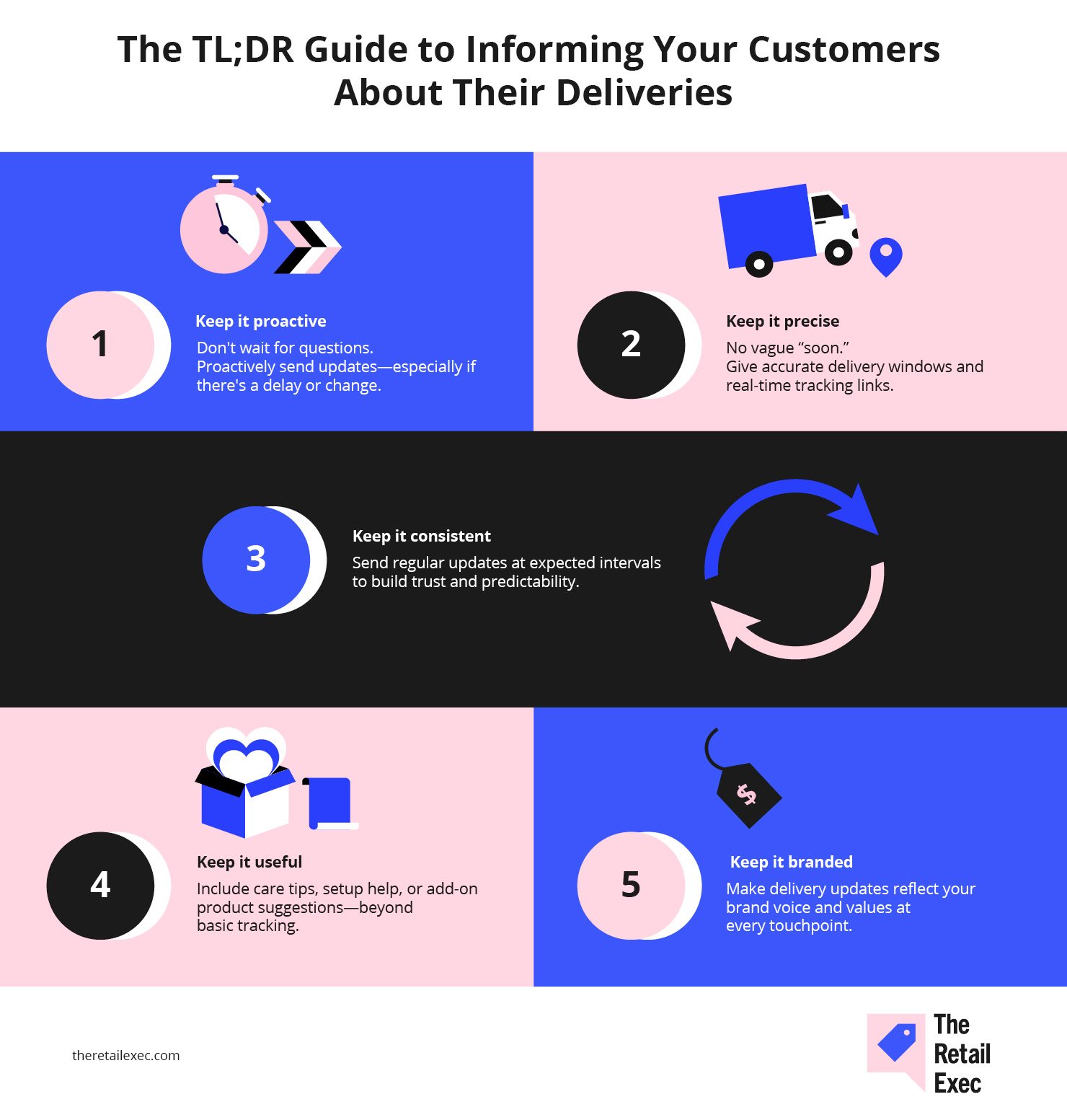
1. Create branded tracking pages instead of redirecting to carriers
The results: A 20% drop in customer-service queries (Joe Spisak, Fulfill.com)
Keep customers in your ecosystem rather than sending them to UPS or FedEx.
“Rather than generic updates, visualizing progress in a branded, engaging way (such as interactive timelines or animated progress bars) has boosted customer engagement,” says Spisak.
A classic example of this is Domino’s real-time pizza tracker:
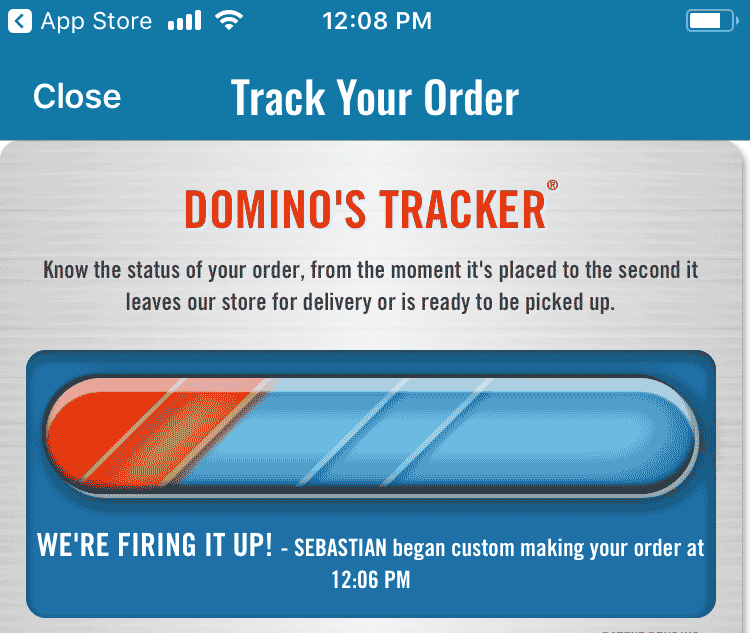
Did you know it’s been around since 2008?
It takes the mystery out of waiting for pizza, plus it is pretty entertaining. After all, who doesn’t get excited when they see that their pizza is ready?!
2. Use GIF-based messaging apps for engaging updates
The results: A 40% boost in customer engagement and significant drop in support tickets (Yarden Morgan, Lusha)
Morgan found that sending fun GIF-based delivery updates through WhatsApp dramatically outperforms regular email notifications.
“When customers receive cute delivery truck GIFs along with their tracking information, they engage more with the updates and are far less likely to contact support asking about their orders,” explains Morgan.
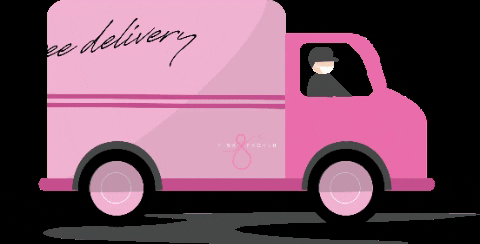
This visual, mobile-friendly approach transforms standard tracking information into an engaging experience that customers actually enjoy receiving.
3. Personalize updates with product-specific excitement
The results: A 34% increase in email open rates and 42% reduction in support tickets (Harmanjit Singh, Website Design Brampton)
Singh transformed generic shipping notifications into what he calls “milestone moments” for a fashion retailer client.
Instead of bland “Your order has shipped” messages, his team crafted personalized notifications with product-specific excitement: “Your new summer collection is on the way! Get ready to turn heads at the beach in just 3 days!”
Singh's most successful notification template follows a simple 3-part structure:
- Clearly state what's happening with the order (status).
- Provide specific timing information (when).
- Include a single clear action step (what to do next).
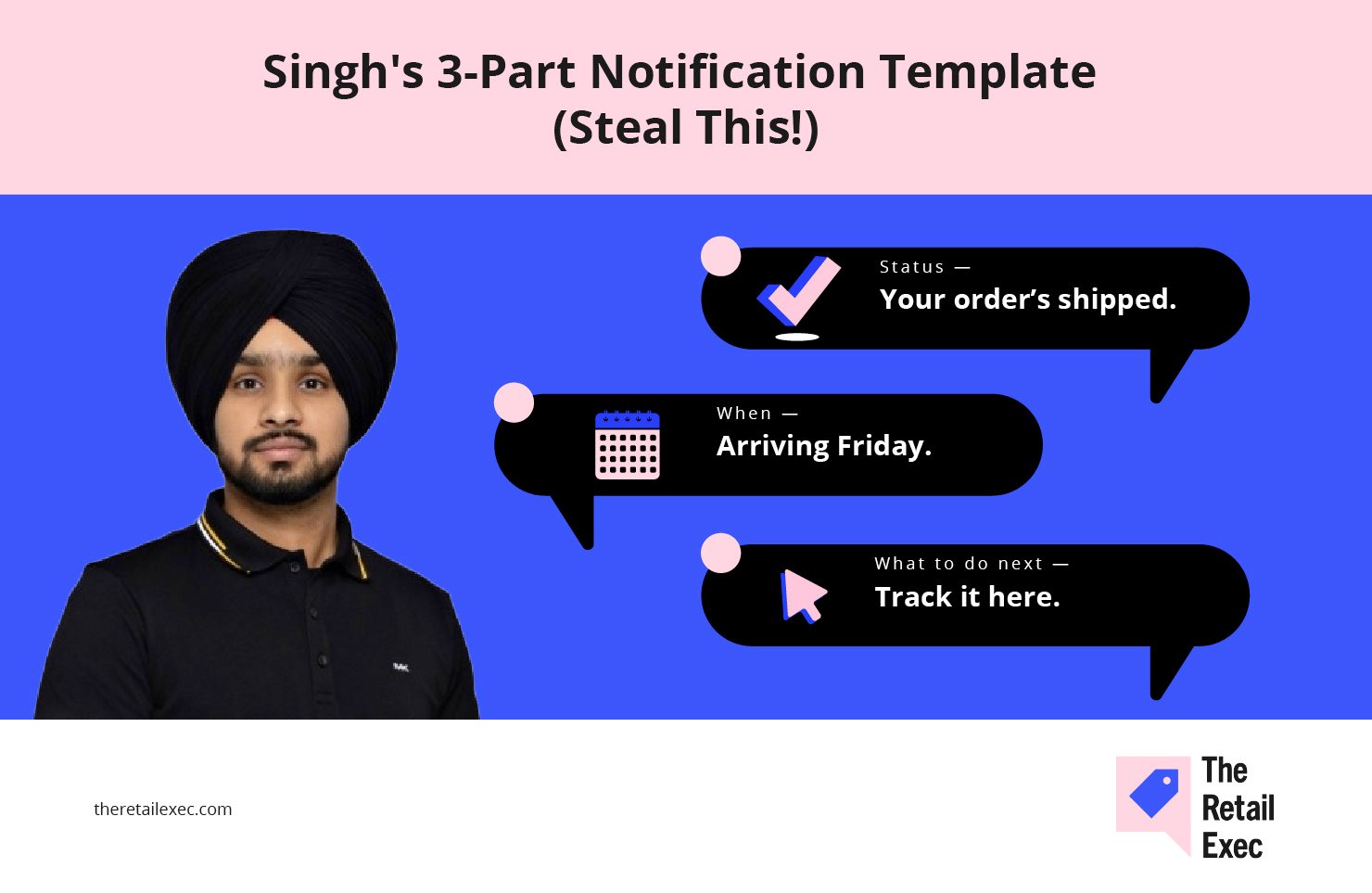
4. Create seasonal and themed tracking notifications
The results: Increased customer excitement and stronger brand connection (John Grant, Premier Bidets)
Grant customizes tracking messages around seasons and holidays to make routine updates feel special:
For Christmas, I might say, ‘Santa's little helpers have packed your order, and it's en route!’ while for Halloween, ‘Your spooky delivery is creeping closer!’ adds a playful touch.
The strategy keeps customers engaged during the waiting period and creates positive associations with the brand—even before the product arrives.
🔥 Real-life example: How Amazon manages pre-parcel anxiety ahead of holiday season
Want to track a package when it's out for delivery? Use Amazon Map Tracking, reimagined as Santa's high-tech sleigh.
Simply select “Track Package” from your orders or shipment email, and voilà—you're plugged into real-time delivery drama!
The map shows exactly where your delivery truck is—almost like you're following Santa's route.
On delivery day, watch your package inch closer on the map. Trying to grab a surprise gift before someone sees it? No problem. Just check the map and time your interception perfectly.
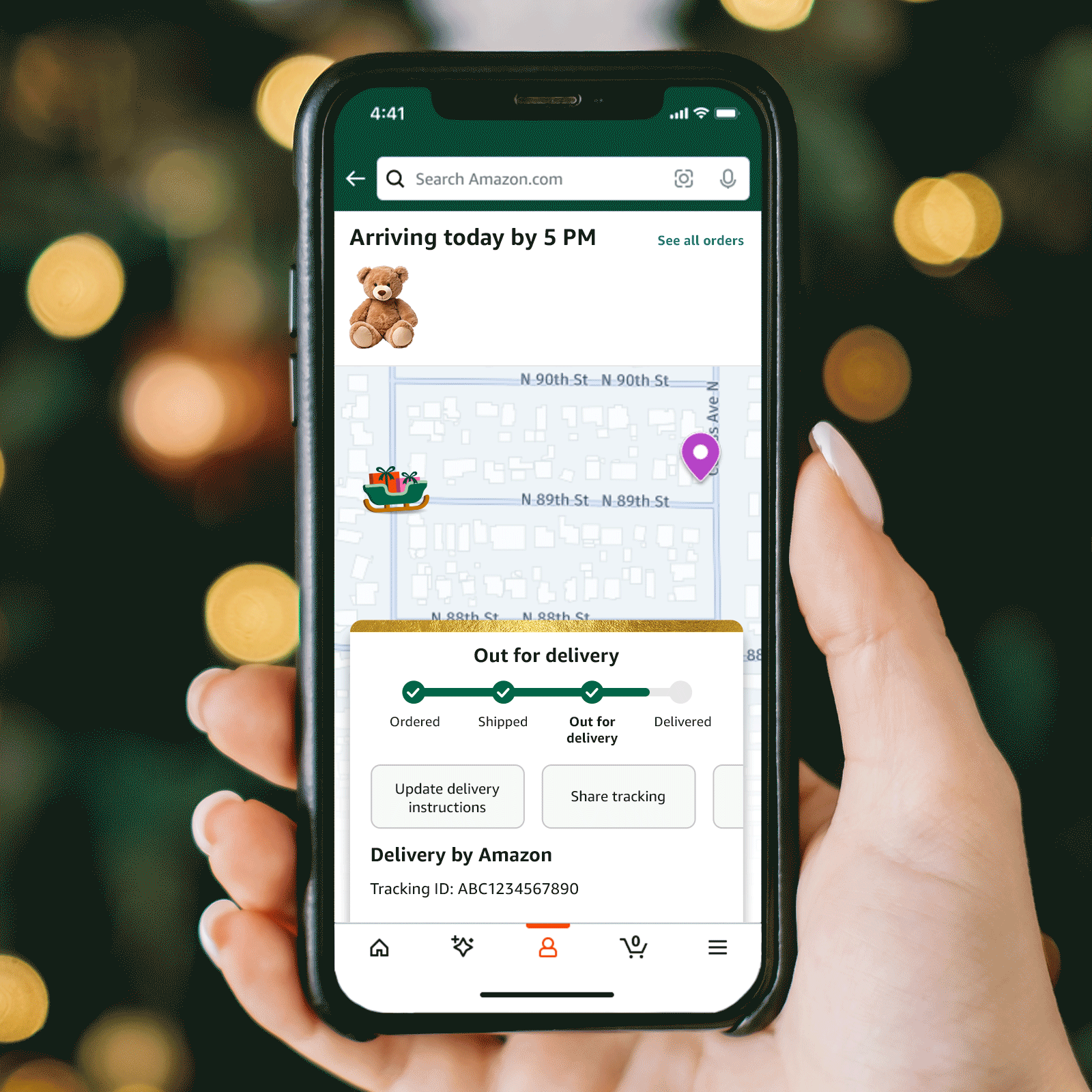
5. Show behind-the-scenes action on social media
The results: A 40% reduction in WISMO support tickets (Ryan Young, Revive Marketing Services)
Young creates quick 15-second Instagram Stories showing his warehouse team packing orders with personalized notes, giving customers a peek behind the curtain of their purchase journey.
And this is a strategy I can personally attest to! For my Instagram store, too, we would regularly upload BTS Stories to serve as a “soft” shipping confirmation:

Also, Young’s strategy doesn't stop at social media.
Young's SMS updates include fun local weather forecasts alongside delivery times—a practical addition that provides context about delivery conditions while entertaining customers.
“I recommend using a mix of channels but keeping WhatsApp as your primary tool since it lets you share live location updates and get instant customer feedback,” Young explains.
This multichannel approach prioritizes visual, immediate updates that satisfy customers' curiosity and reduce their need to contact support teams.
The combination of transparency, personality, and practical information dramatically cuts down on WISMO inquiries while building a stronger connection between brand and buyer.
6. Turn tracking into a mini-series story
The results: Higher customer engagement and excitement during wait times (Lev Peker, CARiD)
Peker turns mundane shipping notifications into an entertaining narrative that unfolds across multiple messages.
His “Delivery Drama Mini-Series” approach transforms the waiting period into an adventure that customers actually look forward to following.
“I start with 'Episode 1: Your order has left the warehouse! Will it survive the journey?' and follow up with 'Episode 2: Out for delivery—only one stop stands between your package and destiny!'” Peker says.
A typically anxious waiting period becomes enjoyable with Peker's humor and storytelling touches.
In response to customer feedback, he continually refines his narrative approach, identifying what stories and themes work best.
7. Use real-time carrier data for accurate delivery estimates
The results: A 20% increase in positive post-purchase reviews (Kiel Tredrea, RED27Creative)
Tredrea personalizes tracking notifications with estimated delivery dates based on real-time carrier data, helping set realistic customer expectations from the start.
“We use a blend of automated SMS and email with optimized design for clarity to update customers during key delivery milestones—such as dispatch, in-transit updates, and delivery success,” Tredrea explains.
This multichannel approach ensures customers receive both immediate alerts (via SMS) and comprehensive information (via email) at each stage of the delivery process.
The system integrates directly with existing ecommerce platforms, like Shopify, to streamline operations and maintain accuracy.
If you don’t have an order tracking system in place, it’s time to get one. Start here:
8. Proactively communicate at key milestones to prevent customer support calls
The results: Reduced WISMO calls by 300+ weekly (Louis Georgiou, Essential Workwear)
Georgiou prioritizes speed and transparency in his delivery communication strategy, focusing on proactive updates at three critical moments: order confirmation, production start, and shipping.
“If there's a delay, customers get a message within 30 minutes explaining the issue,” Georgiou confirms.
This immediate response prevents the uncertainty that drives most customer service inquiries.
While Georgiou uses both email and SMS, he notes that text messages generate significantly faster engagement, with customers typically opening them within three minutes.
This immediate visibility makes SMS ideal for time-sensitive updates that require customer awareness or action.
HOWEVER, to provide these instant updates to customers, you yourself first need to have ironclad backend processes—one of which includes implementing a solid order management solution to automate and access real-time visibility.
Here are 10 bad boys we like:
9. Turn delivery delays into opportunities with apology discounts
The results: A 40% reduction in inquiries and 15% discount code redemption rate (Matt Little, Festoon House)
Little transforms the typically negative experience of delivery delays into a chance to build customer loyalty through transparent communication and meaningful compensation.
“When there are delays, our delivery delay email offers a clear explanation, a tracking link, and a discount code as an apology,” Little explains.
Rather than hiding from problems, Festoon House addresses delays head-on with honest explanations of what happened and what they're doing to resolve it.
For critical issues like significant delays or lost packages, they even make personal phone calls to show genuine concern.
10. Schedule customer order updates based on their preferred times
The results: Doubled engagement rates and a 30% boost in customer retention (Ken Fortney, That Local Pack)
Fortney starts his customer communication strategy before a purchase even happens, using local SEO to make sure businesses are discoverable online.
This foundation of visibility is then built upon with strategic delivery updates.
His team schedules personalized text updates according to customers' preferred times, which has doubled engagement rates for cleaning service clients. Also, they use Google Business Profile to broadcast real-time updates about deliveries and services.
“One of our carpet cleaning clients saw a 30% boost in customer retention by sharing daily insights and updates on their Google page,” notes Fortney.
But you focus on growing your business while an automated customer service solution works in the background to reduce support tickets—here are our top 10 recommendations:
6 Templates to Inform Customers About Their Order Status
Feel free to steal these.
(Make it yours, though. I can tell you from personal experience that receiving a “Hi [Name!]” doesn't activate the warm and fuzzies.)
1. Order confirmation email template
From Vishal Shah, senior technical consultant, WPWeb Infotech:
"Hey [Customer Name], your order #[Order ID] is confirmed! We'll notify you once it ships. Track anytime here: [Tracking Link]. Thanks for shopping with [Brand Name]!"
2. Shipping confirmation SMS
From Matt Little, owner and managing director, Festoon House:
"Your [Brand Name] order #[Order Number] is on its way! Track it here: [Tracking Link]. Light up the night!"
3. Out for delivery notification
From Harmanjit Singh, founder and CEO, Website Design Brampton:
"Great news! Your custom canvas is out for delivery today between 2 PM-4 PM. No signature required, but make sure your porch light is on if arriving after dark."
4. In production/processing update
From Louis Georgiou, managing director, Essential Workwear:
"Your order is now in production! We're embroidering your workwear and expect to ship it by [DATE]. Track your order here: [LINK]."
5. Delivery confirmation/follow-up
From Ollie Smith, CEO, VATcalculators:
"Your package has arrived, [Customer Name]. Love it? Leave a review! Your feedback helps us improve our products for your future purchases.
Need help? Reply here!
Or, contact us at [Customer Phone Number] for urgent queries."
6. Delivery delay update
From Denise Murray, marketing manager, Microdose Mushrooms:
“Subject: Your [Company Name] Order - Here’s What’s Happening
Hey [Customer’s Name],
Just a quick update on your order #[Order Number]:
Status: We’re packing your order now!
Next Steps: It ships via [Shipping Carrier] and should arrive by [New Estimated Delivery Date].
Track Your Order: [Tracking Link]
As a thank you for waiting, enjoy [Discount Code/Free Gift] on your next purchase!
Questions? We’re here to help! Find our contact information below.
Best regards,
The [Your Company Name] Team”
From Pre-Parcel Panic to Customer Delight
Every notification is a touchpoint, every update an opportunity to say, “We've got you covered.”
GIFs, personalized stories, behind-the-scenes peeks, weather-related quips—the world is your delivery communication oyster.
Your packages are more than cardboard and shipping labels. They're promises. And it's time to deliver—literally and figuratively.
Retail never stands still—and neither should you. Subscribe to our newsletter for the latest insights, strategies, and career resources from top retail leaders shaping the industry.
How to Inform Customers About Delivery Status FAQs
The three stages of waiting for a package: anticipation, anxiety, and constantly asking Alexa what day it is. Here’s how to help…
How do you write a delivery message?
Keep it clear, specific, and actionable. Include all relevant order details, such as the order number, expected delivery date/time, and a tracking link.
Add personality without sacrificing information. “Your custom sneakers have left our warehouse and are sprinting to your doorstep by Thursday!” beats “Your order has shipped” every time.
How do you notify a customer for delivery?
Use their preferred channel. SMS for urgency, email for details, or app notifications for convenience. Send updates at key milestones: confirmation, shipping, out-for-delivery, and delivery.
For high-value items, consider a direct call or personalized video message to elevate the experience.
What is a good sentence for delivery?
“Your order is out for delivery today between 2 PM-4 PM. Use this tracking number [tracking number example] to follow the blue van!”
A specific timeframe, practical information, and a touch of excitement make it effective.
How can I use AI to personalize delivery notifications?
AI can analyze purchase history, including recent orders, to customize messaging (“Your third coffee machine this year is on its way!”), predict delivery issues based on weather data, or adjust notification timing based on when customers typically open messages. It can also generate product-specific care tips to include with shipping alerts.




